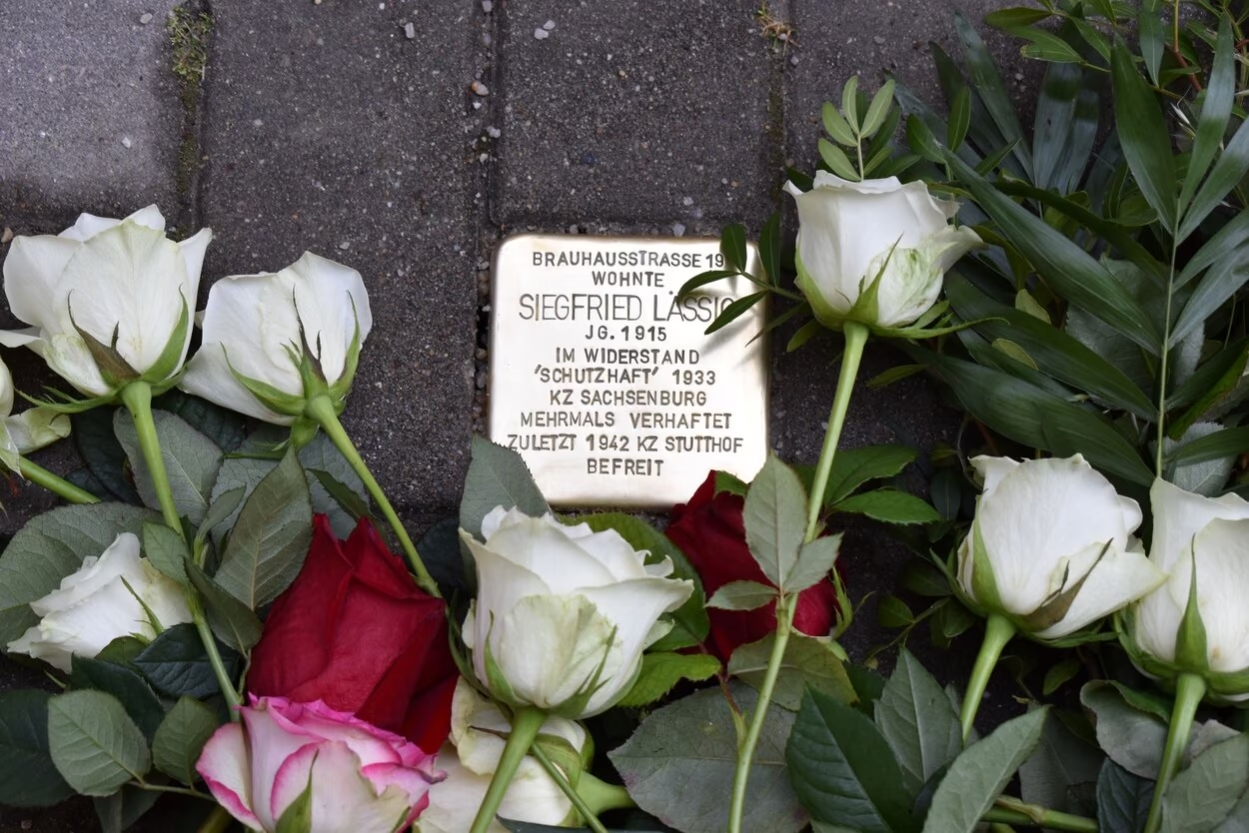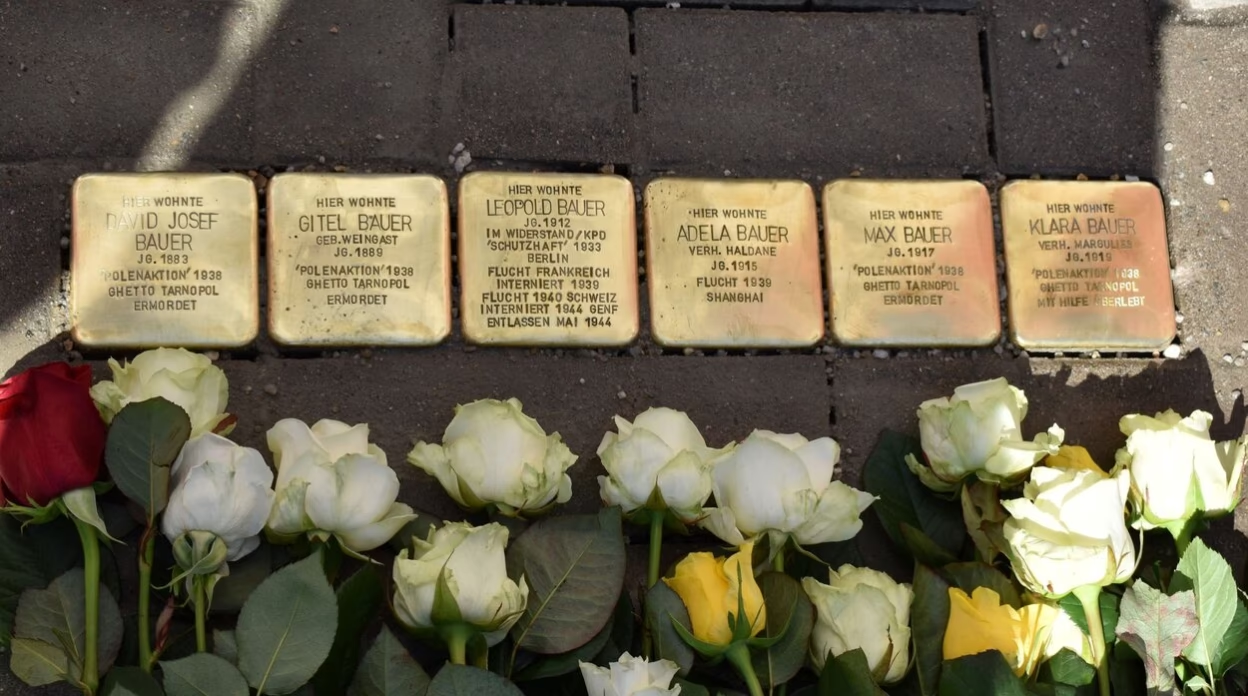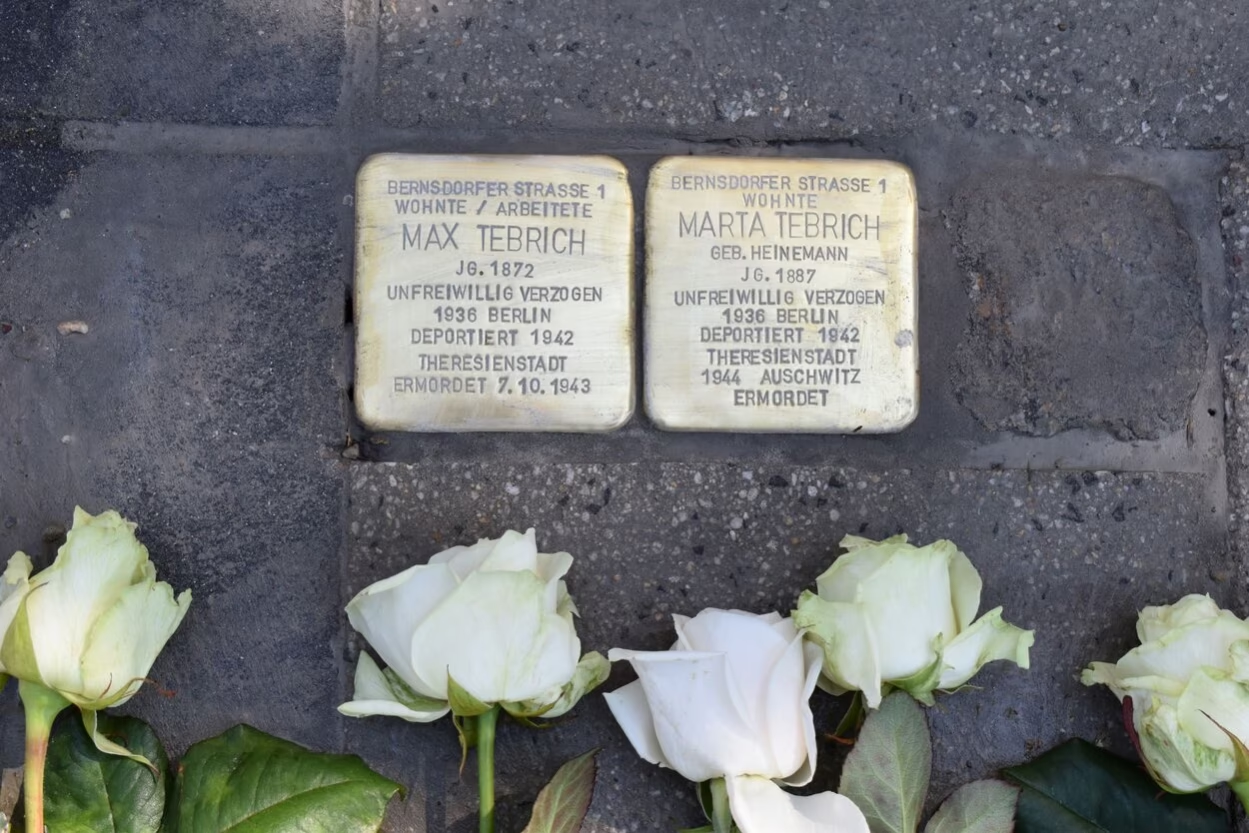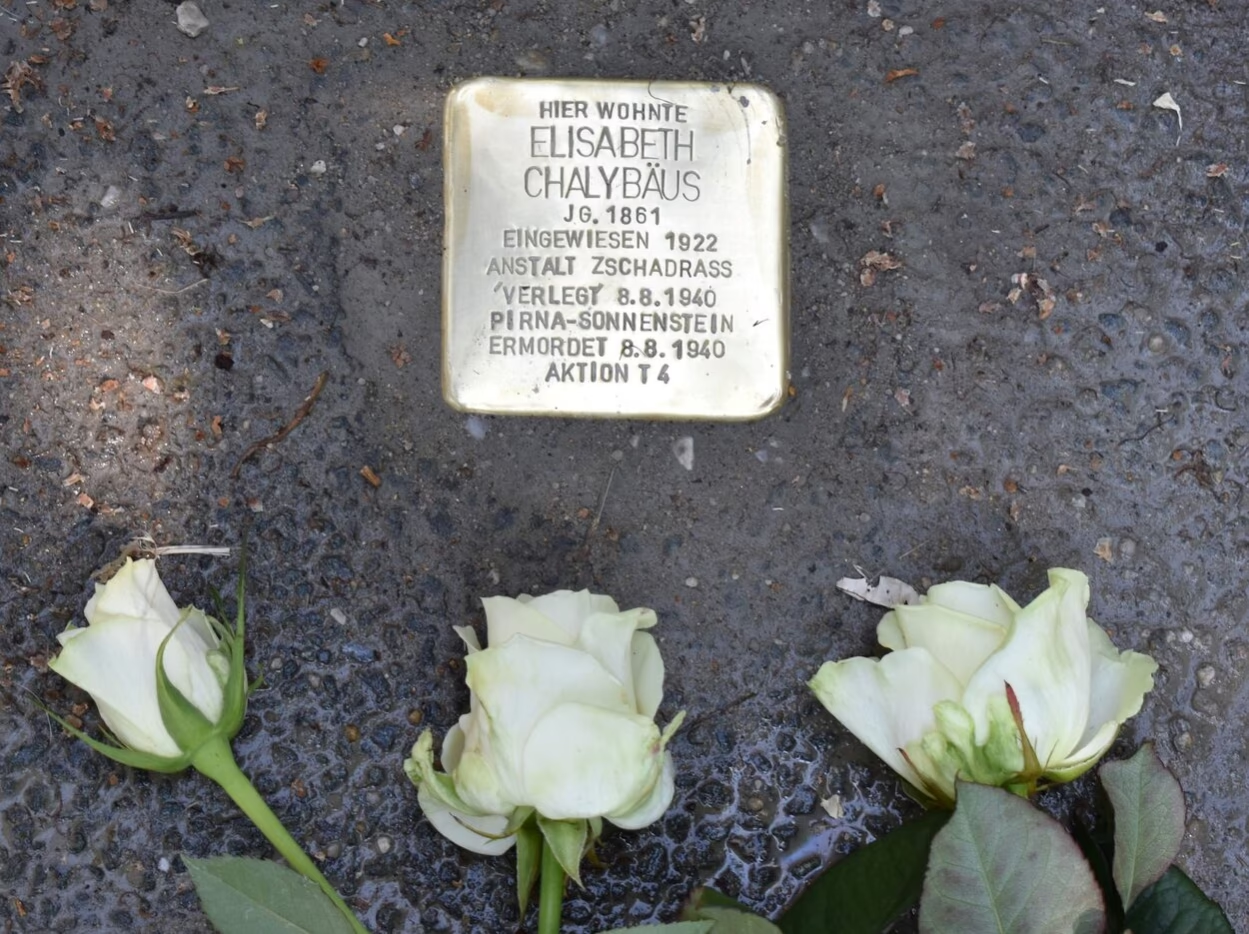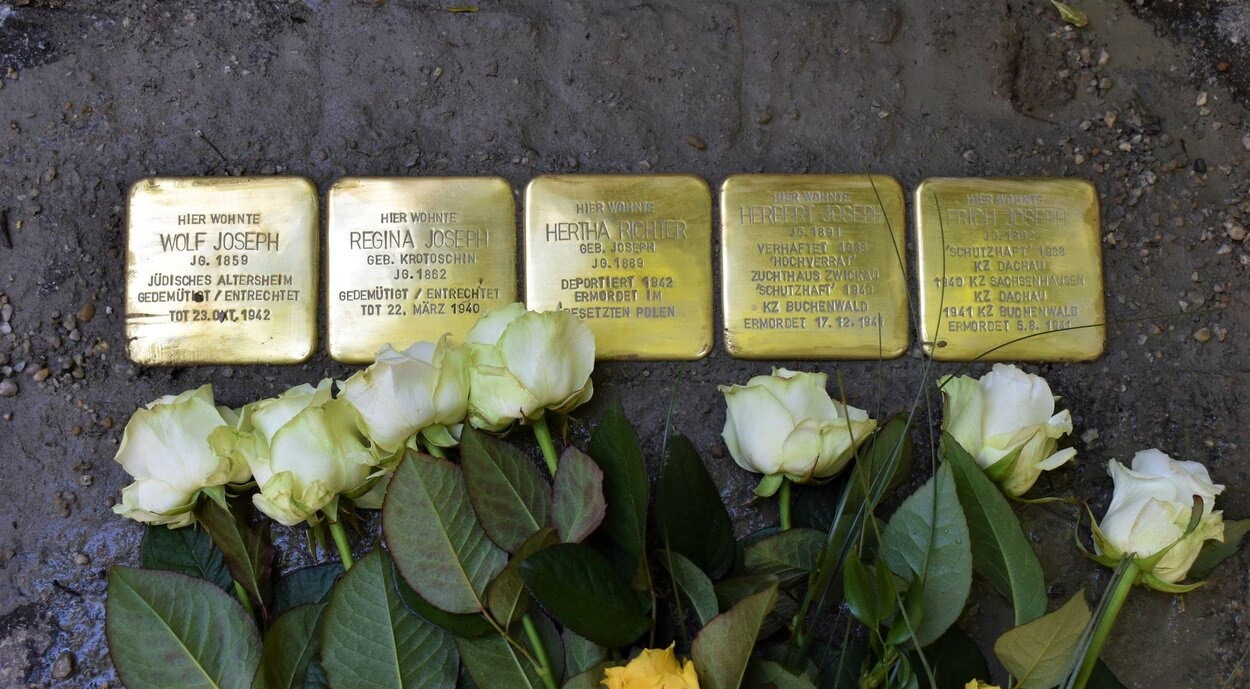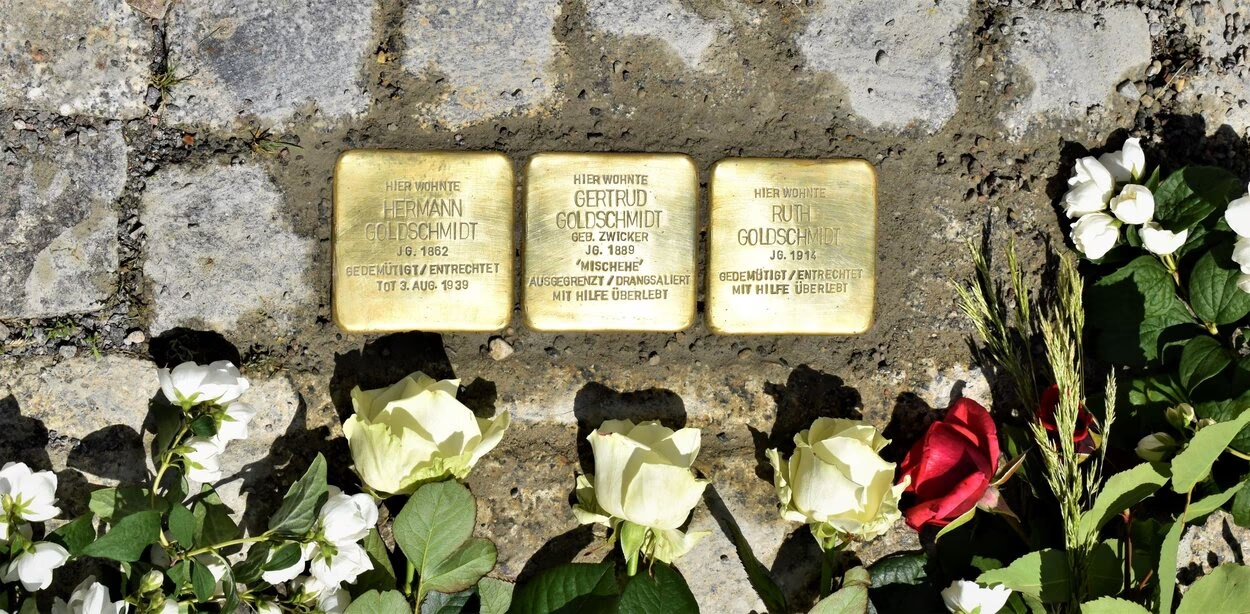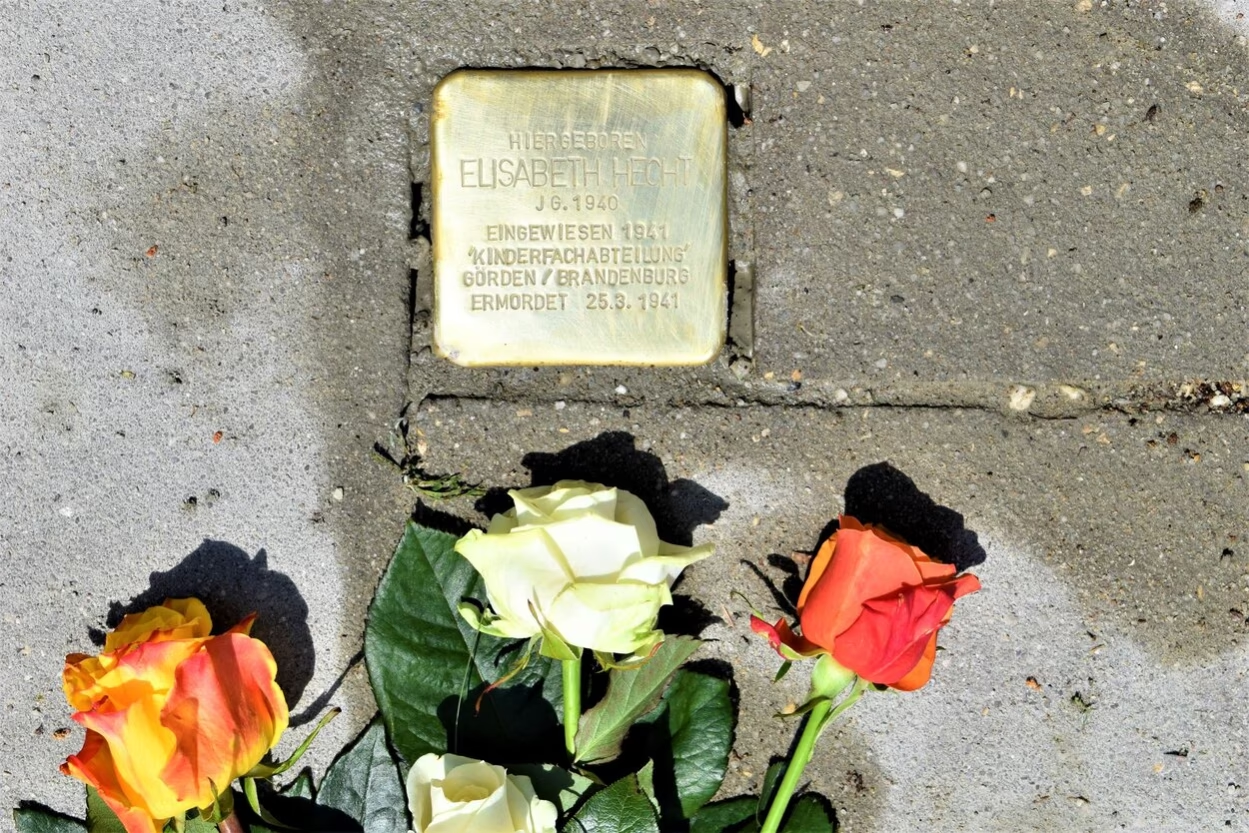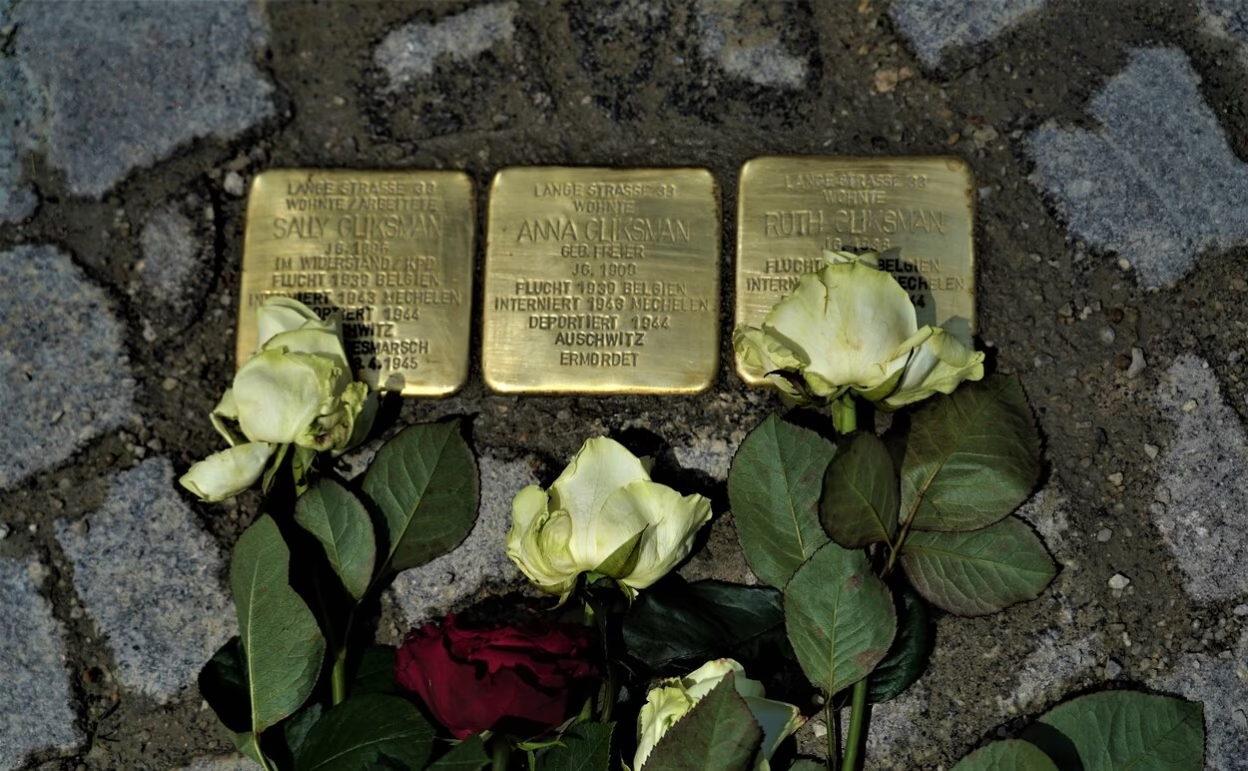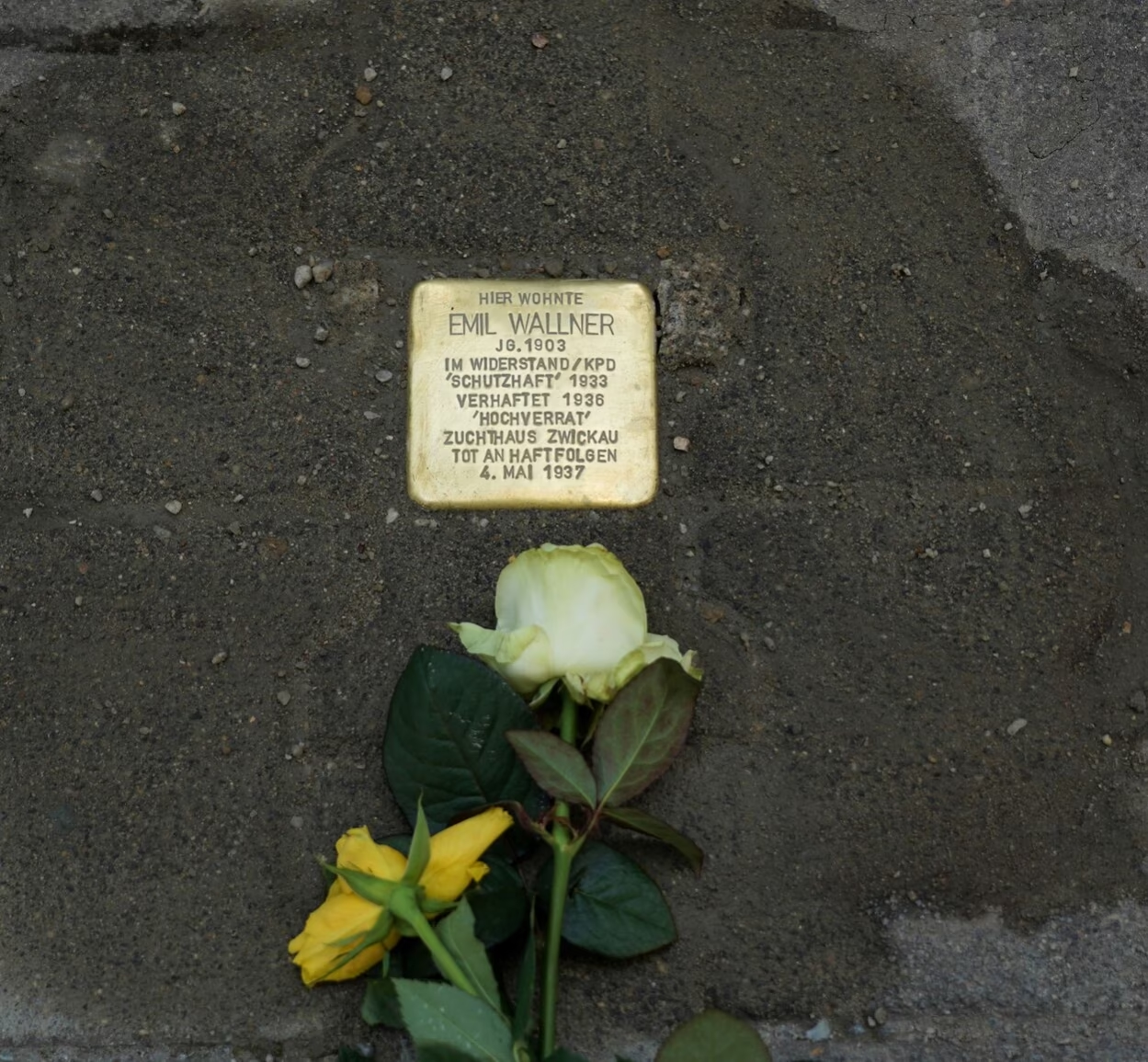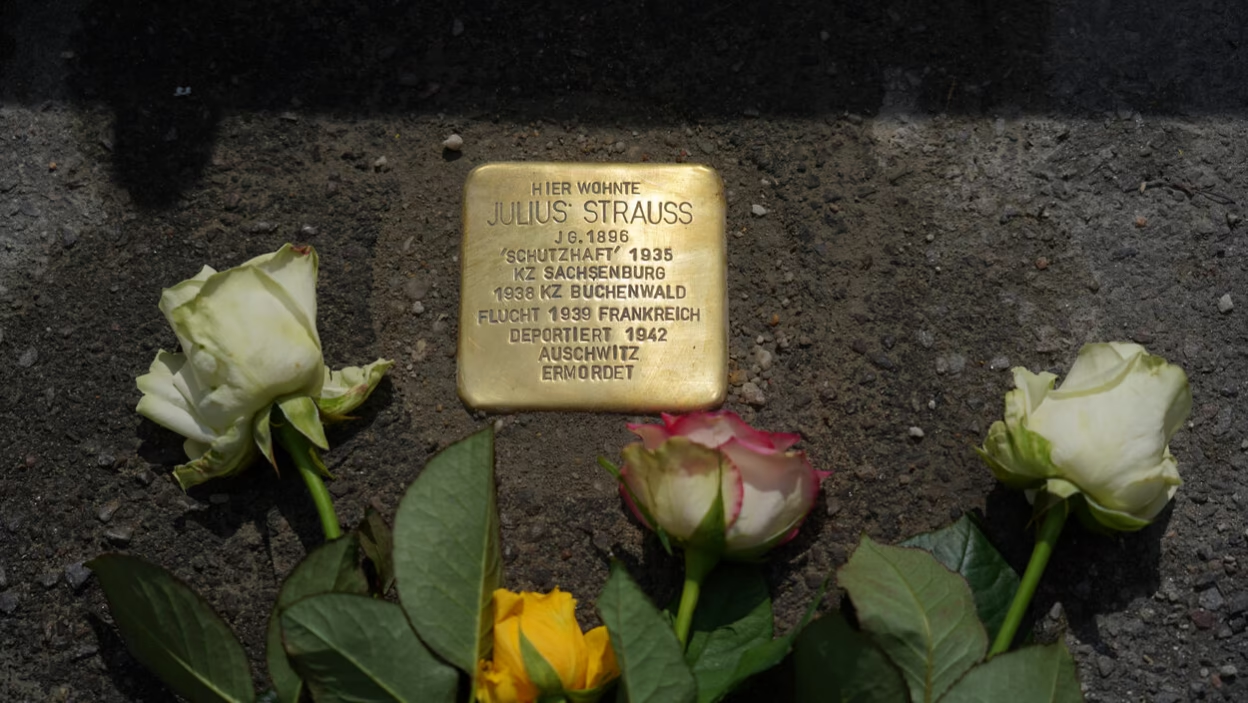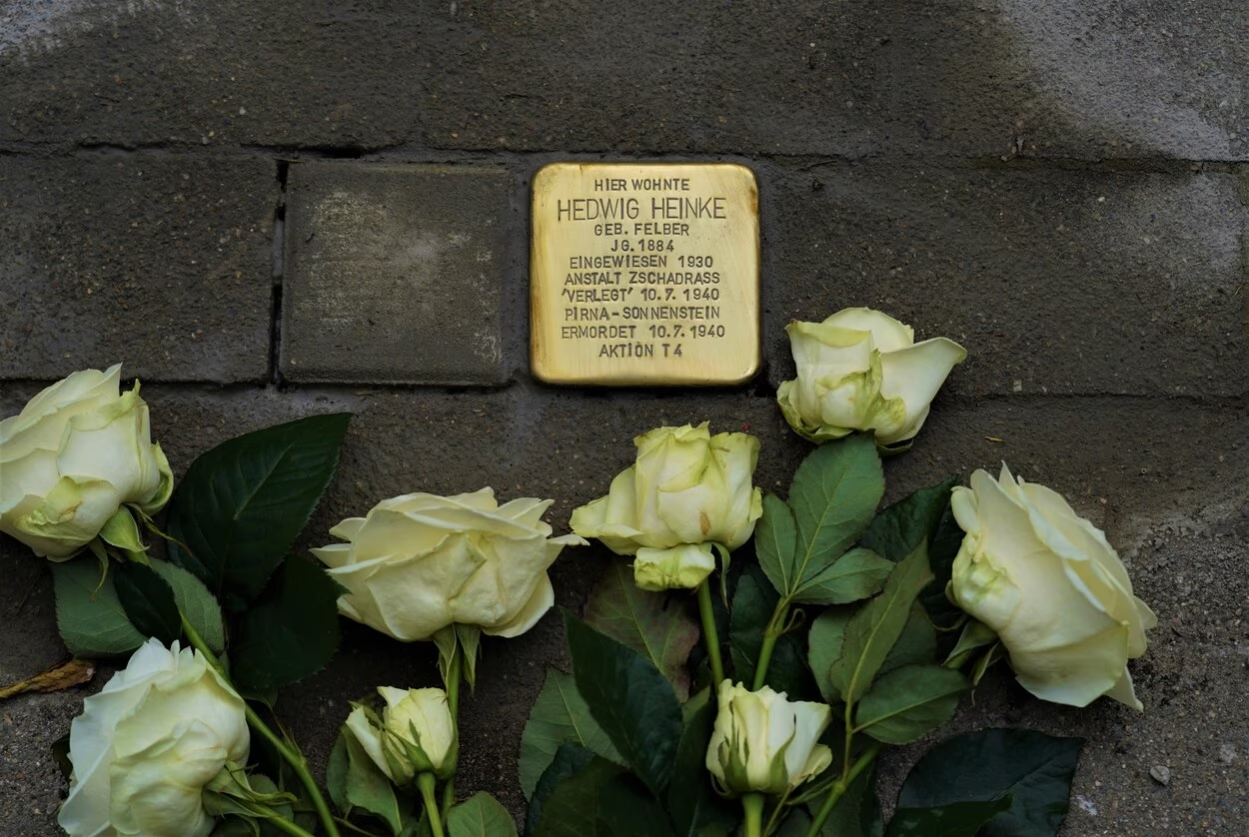Stumbling stone laying on 14 June 2023
On Wednesday, 14 June, 25 new Stolpersteine were unveiled at eleven locations in Chemnitz. In total, more than 300 of the memorial stones in the city now commemorate the fates of people who were persecuted, deported, murdered or driven to their deaths during the National Socialist regime.
Brauhausstrasse 19
Stumbling stone for Siegfried Lässig
Siegfried Lässig was one of the anti-fascists from Chemnitz who were systematically persecuted by the Nazi regime and imprisoned almost continuously from 1933 to 1945. After an odyssey through prisons and concentration camps, he was liberated by the Red Army in March 1945 in a branch of the Stutthof concentration camp and returned to Chemnitz.
Pupils from the Montessori secondary school in Chemnitz, who have also taken on the sponsorship of the stone, will accompany the ceremony with a programme. The Mayor for Education, Social Affairs, Youth, Culture and Sport, Dagmar Ruscheinsky, will welcome those present and Enrico Hilbert, Chairman of the VVN-BdA Chemnitz, will speak about the biography of the honouree.
Sponsors: Pupils from the Montessori secondary school in Chemnitz
Reichenhainer Street 8
Stumbling stones for David Josef, Gitel, Max, Klara, Leopold and Adela Bauer
The self-employed watchmaker David Josef Bauer and his wife Gitel Bauer, née Weingast, were arrested in October 1938 and deported to Poland with their two younger children Max Bauer and Klara Bauer, née Margulies, where they lived in the Tarnopol ghetto from July 1941. Their daughter Klara was the only survivor and emigrated to the USA in 1949. Leopold Bauer, the eldest son, joined the German Socialist Labour Party in 1931 and later the KPD. He emigrated to France in 1933, survived internment and later imprisonment in Switzerland and returned to Germany in 1945. His daughter Adela Bauer, married name Haldane, managed to emigrate to Shanghai and from there to the USA in 1947.
Alongside other descendants of the family, Adela Bauer's son David Haldane and his daughter will be travelling from the USA to attend the laying of the Stumbling Stones. Pupils from Georgius Agricola Grammar School will accompany the laying of the stones with a short programme.
Sponsors: Franziska Plickat, Kollektiv 58, Michael Müller, Georgius-Agricola-Gymnasium, Susanna Herzog, Julia Plickat and Gayle Schreiber Margulies
Bernsdorfer Straße 1, today next to Ritterstraße 17
Stumbling stone for Max and Marta Tebrich
Under pressure from the National Socialists, pharmacist Max Tebrich was forced to give up the Rosen pharmacy he ran in Chemnitz in 1936 and leave the city together with his wife Marta Tebrich, née Heinemann. In Berlin, the couple were initially forced to move to a Jewish retirement home in November 1942, from where they were deported to Theresienstadt a few days later.
Sponsors: Beate and Dr Bernd Flade, Stephan Lazarides
Heinrich-Beck-Straße 38, today at Heinrich-Beck-Straße 47
Stumbling stone for Elisabeth Chalybäus
Elisabeth Chalybäus, who used to work as a private teacher, was transferred to the mental hospital in Hilbersdorf several times in the summer of 1921 due to the deterioration of her mental health and was finally transferred to the sanatorium and nursing home in Zschadraß in April 1922. She remained there until 8 August 1940, when she was transported with 89 other patients to the Pirna-Sonnenstein killing centre and murdered.
Godparents: Gerhard Schwindt, Hans-Martin Schwindt and Dorothea Specht
Agricola street 9
Stumbling Stones for Wolf, Regina, Hertha, Herbert, Erich Joseph
The merchant Wolf Joseph, owner of a company specialising in upholstery fabrics and curtains, had four children with his wife Regina Joseph, née Krotoschin. After their divorce, the eldest daughter Hertha Richter, née Joseph, returned to live with her parents in Agricolastrasse, while her two sons emigrated to Palestine. She was deported to the East in July 1942. Their son Herbert Joseph founded his own company based in Chemnitz, which he was forced to sell after his arrest in 1938. He died in Buchenwald concentration camp in December 1941. His son Erich Karl Joseph was taken into "protective custody" during the pogroms on 12 November 1938 and was later transferred to Sachsenhausen, Dachau and finally Buchenwald, where he died in August 1941. Only his daughter Elsa managed to emigrate to England in 1939.
The parents finally lived in the "Jews' house" at Agricolastrasse 9, where the mother died as a result of a tragic household accident in March 1940. The widower Wolf Joseph, who was badly affected, last lived in the Jewish retirement home on Antonplatz, where he died in October 1942.
Godparents: Mike Wirrig, Susanne Stelzer, Ilka Lange, Ulrike Riethmüller and Thomas Wabst, private
Kurfürstenstraße 2, today Puschkinstraße 2
Stumbling stones for Hermann, Gertrud and Ruth Goldschmidt
The Jewish merchant Hermann Goldschmidt converted to Protestantism in 1906, but had to suffer countless humiliations during the Nazi era due to his Jewish origins. His wife Gertrud Goldschmidt, née Zwicker, and their daughter Ruth Goldschmidt were only able to organise his funeral in 1939 at the Chemnitz municipal cemetery with great difficulty. Daughter Ruth was conscripted into forced labour as a half-Jew in 1944. Mother and daughter narrowly escaped deportation at the end of the war, but lost all their possessions on the night of the bombing on 5 March 1945.
Godparents: Dorte Munck, parish of St Jakobi-Kreuz Chemnitz, Mike Wirrig
Flemmingstraße 4
Stumbling stone for Elisabeth Monika Hecht
Elisabeth Monika Hecht was one of the children who fell victim to National Socialist "euthanasia". Physically disabled from birth, she was admitted to the "paediatric ward" in Brandenburg-Görden by the authorities after being reported to the health authorities by the clinic, where she died at the age of just four months.
Sponsor: Wollmann family
Lange Straße 33, today near Am Rathaus 8
Stumbling stones for Sally, Anna and Ruth Gliksman
Sally Gliksman, a trained tailor and owner of a men's clothing shop in Chemnitz from 1926, supported the Chemnitz anti-fascists after the National Socialists came to power. After the November pogroms, he emigrated to Belgium; his wife Anna Gliksman, née Freier, followed him a short time later with their daughter Ruth Gliksman. The family was arrested there in December 1943, at the time of the occupation of Belgium by the German Wehrmacht, and deported to Auschwitz in January 1944. Sally Gliksman survived the camp and the death march in 1945. He returned to Chemnitz in September 1945, where he rejoined the Jewish community and became active on the board. His wife and their daughter were murdered in Auschwitz.
Godparents: Raimund Köhnen, Manuela Köhnen, Oberschule Am Flughafen
Annaberger Street 200
Stumbling stone for Emil Wallner
The Chemnitz anti-fascist Emil Wallner was active as a member of the KPD at the Chemnitz power station, where he was employed as a locksmith. After being dismissed without notice for his work for the Revolutionary Trade Union Opposition in 1933, he was arrested in 1935 for illegal work for the banned KPD. He was sentenced to two years and ten months in prison by the Dresden Higher Regional Court for "preparation for high treason". The severe abuse he suffered during his imprisonment led to his death in May 1937.
Sponsor: Christian Seeling
Heimgarten 100
Stumbling stone for Julius Strauß
The successful businessman Julius Strauß was one of the Jewish soldiers who fought in the First World War. After the early death of his wife, the widower moved into Heimgarten 100 with his two sons. He was arrested on 7 September 1935 and transferred to Sachsenburg concentration camp. After a brief release, he was arrested again on 10 November 1938 and taken to Buchenwald. He was released on 1 December on condition that he leave Germany. However, even in France he did not escape the terror of the regime and was deported to Auschwitz and murdered after his arrest in August 1942.
Sponsors: private
Euba, No. 125, today Hauptstraße 137a
Stumbling stone for Hulda Hedwig Heinke, née Felber
Hulda Hedwig Heinke, née Felber, grew up in Euba with five siblings and was brought up in the Protestant-Lutheran tradition by her parents. After marrying Ernst Heinke, the childless couple moved to Chemnitz. At the age of 45, she was admitted to the Chemnitz-Hilbersdorf municipal mental hospital due to the deterioration of a progressive nervous system disorder and was transferred from there to the state sanatorium and nursing home in Zschadraß shortly afterwards. On 10 July 1940, Hedwig Heinke was taken to the Pirna-Sonnenstein killing centre as part of "Aktion T4", where she was probably murdered with gas on the same day.
Sponsor: Angela and Frank Hohaus


